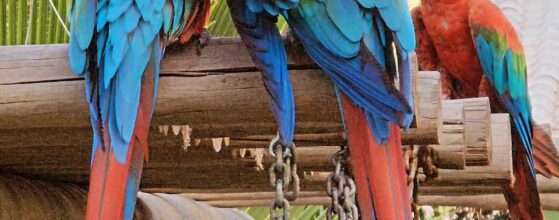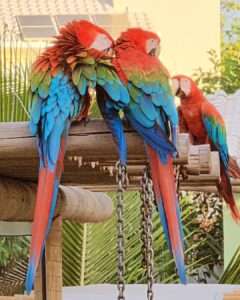
- by FPABS-Admin
- 0
- Posted on
Scarlet macaws

 Scarlet macaws are diurnal birds that gather in flocks at night. In the morning they will often fly a long distance to find food, flying in small groups or pairs, often calling to each other in hoarse raucous voices. They make nests in tree hollows. If in their nest and danger presents itself, they will cautiously examine the scene until the danger has gone. If their nest is directly threatened, the birds quietly escape to a place of safety. Scarlet macaws often use their left foot when handling food and grasping other objects. They communicate by means of a range of postures and vocalizations.
Scarlet macaws are diurnal birds that gather in flocks at night. In the morning they will often fly a long distance to find food, flying in small groups or pairs, often calling to each other in hoarse raucous voices. They make nests in tree hollows. If in their nest and danger presents itself, they will cautiously examine the scene until the danger has gone. If their nest is directly threatened, the birds quietly escape to a place of safety. Scarlet macaws often use their left foot when handling food and grasping other objects. They communicate by means of a range of postures and vocalizations.
Diet and Nutrition
Scarlet macaws are herbivores. In the wild, these birds like to eat mostly nuts, fruits, and seeds, some large, hard seeds amongst them. Sometimes they seen eating clay at river banks. They now and again supplement their diet with flowers and nectar. lso love to eat insects and larvae. They seen feeding heavily on bugs, snails, and foliage.

Mating Habits
Scarlet macaws are monogamous and they bond for life. Once they have form a pair, they hardly ever seen alone except to feed while the other bird incubates the eggs. Mates show affection by mutual preening and licking each other’s faces. About every one or two years breeding occurs. It is mainly the females who incubate the eggs. The young stay with the adults for up to one to two years. Males and females both care for the chicks. The parents do not raise another clutch until the first chicks have become independent. Young Scarlet macaws become reproductive mature by 3 or 4 years of age.
Domestication
The Scarlet macaw has been bred in captivity for a long time first at Paquime in Northern Mexico in the 11th century. The Scarlet macaw today is in captivity worldwide mostly in the Americas. People pose a threat to this species but they can also help their population in that captive techniques develop in the pet trade can have a positive effect on wild populations as where there are low macaw populations extra chicks that would normally die in the nest can be rear by humans and release back into the wild.
Habits and Lifestyle
Scarlet macaws monogamous and they bond for life. Once they have form a pair, they hardly ever seen alone, except to feed while the other bird incubates the eggs. Mates show affection by mutual preening and licking each other’s faces. About every one or two years breeding occurs. 2 to 4 round white eggs laid, and incubat for around 24 to 25 days. It is mainly the females who incubate the eggs. The young stay with the adults for up to one to two years. Males and females both care for the chicks. The parents do not raise another clutch until the first chicks.
